Projecting the Top 50 Players of the 2019-20 College Basketball Season


Ahead of the 2019-20 college basketball season, we're projecting who its top 50 players will be. In constructing our rankings, we considered a number of factors: previous college production (or, for freshmen, high school/recruiting pedigree), a player's natural ability, how big of a role he's expected to play on his team, what a sizable expectation for year-to-year improvement is and, not least of all, how important he will be to his team's success.
That means this is not a list of which players have the best NBA prospects, or play for the best overall teams, or might wind up with the best NCAA or professional careers. It's a projection for the 2019-20 college hoops season only, and while things like NBA draft stock might naturally have overlap with such a ranking, it was not a determiner here.
Without further ado, we present the top 50 players for the upcoming college basketball season:
50. Antoine Davis, Detroit Mercy, Sophomore
Davis is a fascinating player who will provide plenty of fireworks on a Detroit Mercy team that is ineligible for the 2020 postseason. The son of coach Mike Davis, Antoine is hoping to take an unorthodox path to his NBA dreams and has perhaps the greenest light in the nation. As a true freshman last season, he was third nationally at 26.1 points per game, including attempting 347 threes and breaking Stephen Curry’s single-season freshman record with the 132 he made. Expect the 6’1” Davis to keep raining them in from deep (he shot at a solid 38% in 2018-19), but he also spent the offseason bulking up in an effort to improve his all-around game and become more than just a high-volume sharpshooter.
49. Zavier Simpson, Michigan, Senior
Simpson is one of multiple point guards on this list who is defense-first, and his tenaciousness makes him the perfect architect of a stingy Wolverines D that looked to cut opponents off at the perimeter last season. He ranked third nationally in defensive win shares and, even in a new system under Juwan Howard, should be lockdown on that end again. Offensively, the undersized Simpson is a strong facilitator (No. 6 assist-to-turnover-ratio) who is oft-used in the pick-and-roll and famously developed a nifty sky-hook. At the same time, he’s yet to truly develop from the outside (29.6% from three for his career) and isn’t a guy who will carry an offense most nights.
48. McKinley Wright IV, Colorado, Junior
A weak schedule kept Colorado from the breakthrough it was hoping for despite 23 wins in 2018-19, but the return of nearly everyone portends bigger things. Perhaps most crucial was the return of Wright IV, the 6’0” point guard who makes the Buffaloes go. He didn’t make an overly large jump as a sophomore, but he improved his shooting across the board and served as a steadying guide, dishing out assists to help five other Buffs players average at least 8 points. If he can cut down on turnovers, he could take the next step this winter.
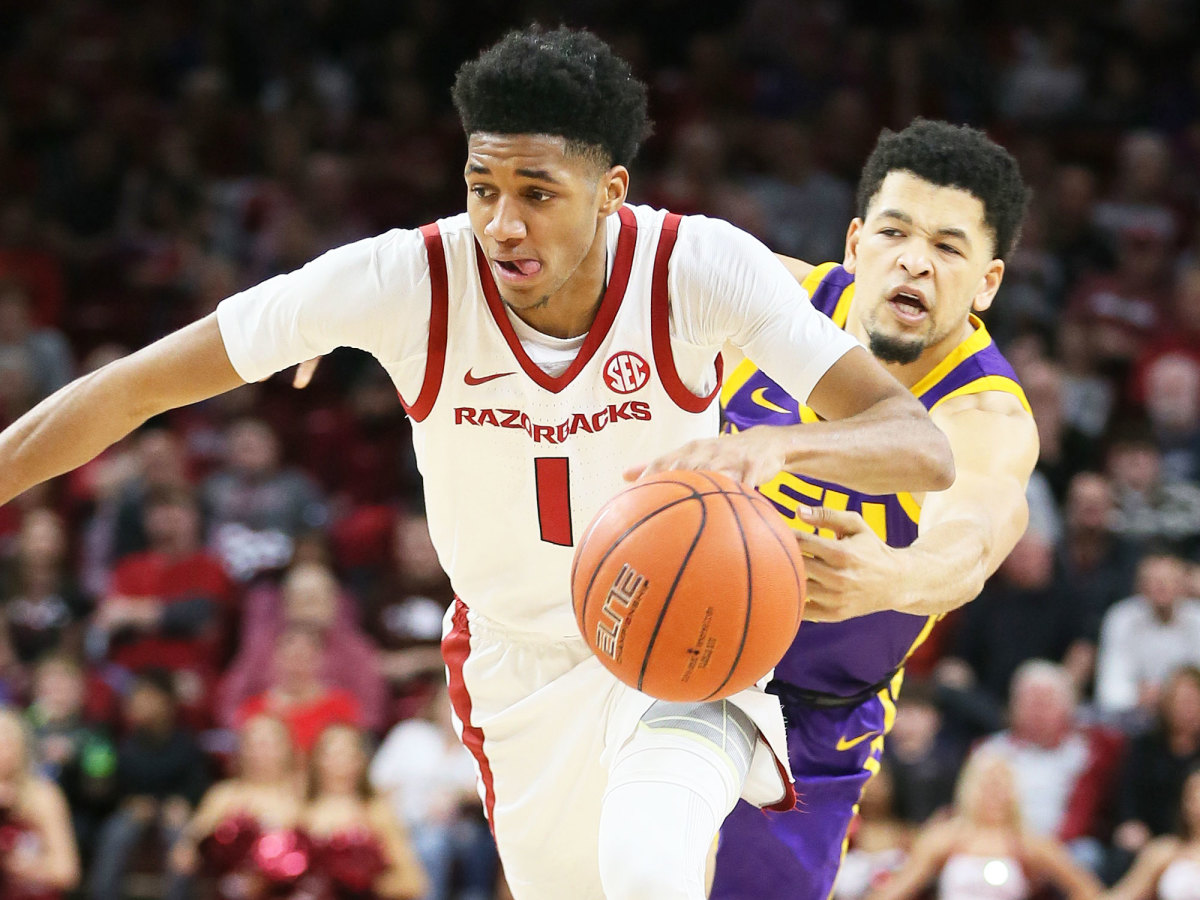
47. Isaiah Joe, Arkansas, Sophomore
Although he was far from a household name, Joe put together an unusually prolific shooting year for freshman, attempting eight threes per game and draining 41.4% of those attempts. Arkansas may play at an even faster pace under Eric Musselman this season, and with Daniel Gafford off to the NBA, Joe looks set to lead the Razorbacks in scoring and make an even bigger splash statistically. If he maintains his effectiveness and adds to his off-dribble game, he should be one of the tougher players to account for, and a sneaky-intriguing prospect for the NBA, as well.
46. Kira Lewis, Alabama, Sophomore
The most important recruiting new Alabama coach Nate Oats did after taking the job in March was convincing Lewis, then in the transfer portal, to return to Tuscaloosa. The 6’3” guard played his entire freshman season as a 17-year-old, averaging 13.5 points and 2.9 assists while shooting a respectable 35.8% from three. Lewis can play anywhere in the backcourt and could excel in Oats’s high-tempo, guard-oriented system (his Buffalo team’s offensive possessions were the fourth-shortest in the country in 2018-19, per kenpom) as the Tide look to bounce back from an NIT season.
45. Lamar Stevens, Penn State, Senior
Stevens was named All-Big Ten first-team last season despite his Penn State team missing the NCAA tournament, a sign of his dominance on a team that came on down the stretch. While the big man lacks in efficiency (46.3% from two, 22.0% from three) there’s no questioning his production, averaging 19.9 points, 7.7 rebounds and 2.1 assists as a junior while playing more minutes per game than anyone in the Big Ten. The Nittany Lions are an intriguing bubble team heading into 2019-20, but one thing you can pencil in is Stevens doing his thing down low as their dominant force.
44. Scottie Lewis, Florida, Freshman
Known for his extreme competitiveness and high defensive potential, Lewis is a quick-twich athlete who could take a starring role for Florida early in the season. He’s explosive and a capable slasher who need only iron out his three-point shooting to be among the best freshmen in the country. The Gators hung their hats on defense last season, and Lewis will be a big aide in that department, capable of defending just about any opponent on the perimeter. He also excels playing in transition, where his passing ability and long strides give him a real advantage. If he takes quickly to the college game, watch out.
43. Chris Clarke, Texas Tech, Senior
Clarke is expected to play a leading role on a new-look Texas Tech team that should be competitive once again. The Virginia Tech transfer is a tenacious, athletic defender who will fit right in with Chris Beard’s style of play, and may also see some time handling the ball and initiating offense as the Red Raiders mix and match. Clarke’s effort and intensity can be tone-setting, and he should contribute across the board with his versatile skills.
42. Alpha Diallo, Providence, Senior
Diallo has had a nice career arc at Providence, increasing his production each season while growing into becoming the Friars’ go-to offensive option last season. He even showed off an improved three-point shot as a junior, though it was only at 33.3%. A beast on the boards, the 6’7” forward’s value extends to the defensive side as well, where he led the Big East in win shares. With a lot of pieces back, Providence looks in line to rebound from a down year, with Diallo once again at the center of things.
41. Naji Marshall, Xavier, Junior
Xavier is a trendy preseason pick to be a team that goes from the NIT to contending in its conference, and Marshall, last season’s leading scorer, is a big part of that. A do-it-all type of player, he averaged 14.7 points, 7.2 rebounds, 3.4 assists and 1.1 steals, and the 6’7” wing was particularly effective at the rim. The next step for him is becoming more efficient, especially beyond the arc. Despite leading the Musketeers by attempting 173 threes last season he shot just 27.7%, an obvious weak point holding back his full potential.
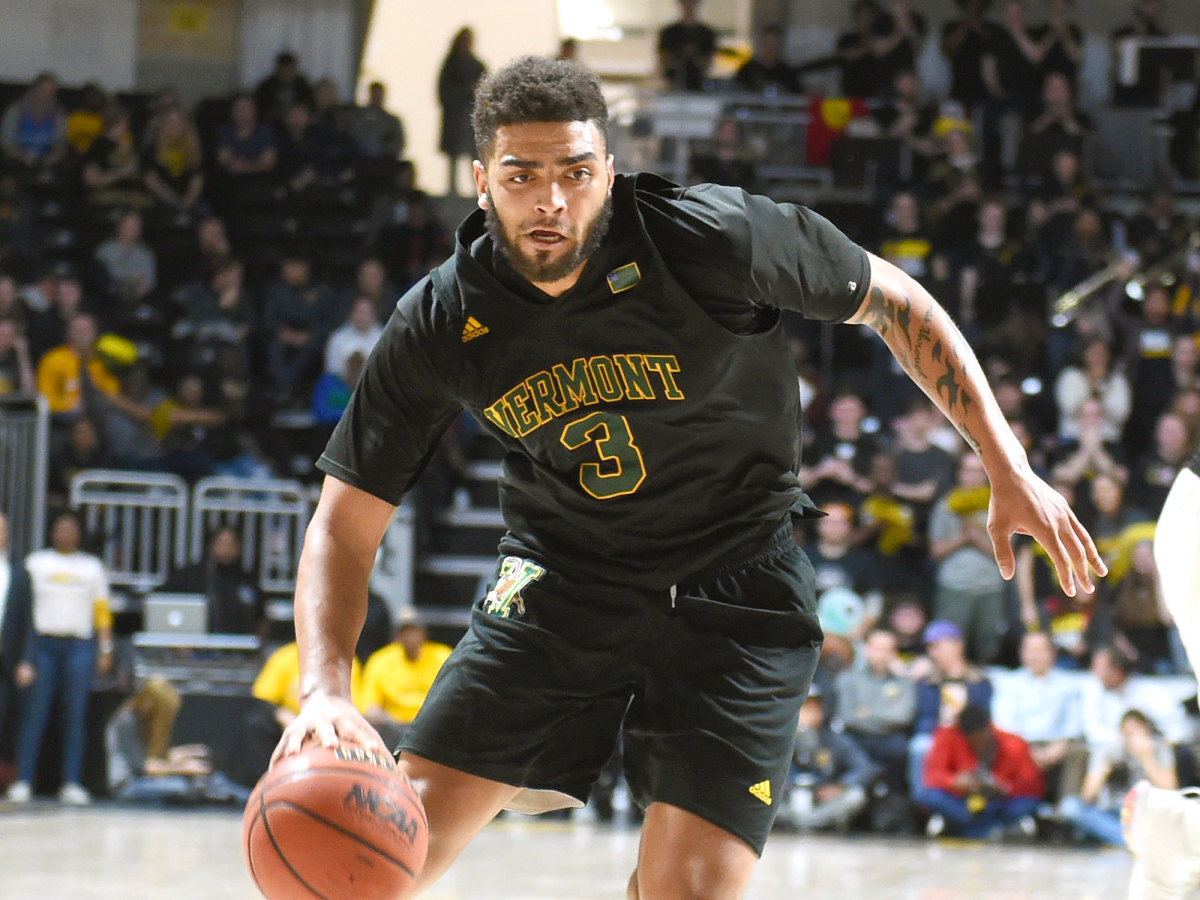
40. Anthony Lamb, Vermont, Senior
Expect Vermont to roll through the America East again and cause trouble in the postseason, with Lamb leading the way. His versatility and all-around impact within the Catamounts’ scheme has led to huge success (77 wins the past three seasons), and the way he racks up points, rebounds, assists and blocks is all the more impressive given his team’s plodding tempo. Expect the wins and the numbers to continue piling up.
39. Reggie Perry, Mississippi State, Sophomore
Perry came to Starkville with high expectations and made good on them during a strong freshman season, averaging 9.7 points and 7.2 rebounds and being one of the nation’s most productive players on both ends of the boards. He was also fifth in SEC play in free throw rate and knocked down his attempts at a 71.6% clip. Now, expect the 6’10” Perry to become the focal point of the Mississippi State offense, and he’ll need to shoulder a lot of the load for a team hoping to avoid a step back after multiple key departures.
38. Anthony Cowan, Maryland, Senior
Cowan has started all 99 games of his college career and is Maryland’s first senior point guard since Gary Williams was coaching. As a junior last season, he was the elder statesman of a young team, and sometimes bore the brunt of that youth in the form of the responsibility of trying to make things happen offensively, especially late in the shot clock. Between that and a second-half shooting slump his efficiency dipped, but he still averaged 15.6 points and will play a key role this year for a preseason top-10 team. The 6'0" Cowan has reportedly bulked up in an effort to improve his finishing and could reap the rewards of a talented supporting cast that’s a year older.
37. Joe Wieskamp, Iowa, Sophomore
Wieskamp is perhaps being overlooked as a big-time breakout candidate for 2019-20, despite starting all 35 games for Iowa and averaging 11.1 points while shooting 42.4% from three as a freshman. His effective field goal percentage and true shooting percentage were both top 10 in Big Ten play, and now the question is if the 6’6” wing if can stay efficient with higher usage. Wieskamp was only the seventh-most used Hawkeyes player when it came to number of shots taken when on the floor, a number that is sure to increase (perhaps dramatically) after Iowa lost two starters and possibly won’t have point guard Jordan Bohannon, either.
36. Jordan Ford, Saint Mary's, Senior
Ford flies under the radar playing out west in the WCC, but that could change this year given Saint Mary’s preseason Top 25 status. A crafty guard who shoots nearly 42% for his career from three, Ford is efficient both inside and outside the arc with an ability to score from all three levels. His return to Moraga is a big reason expectations are high for the Gaels, and he has the ability to turn in another year similar to his 21.1-point, 2.5-assist, 1.3-steal campaign last season.
35. Neemias Queta, Utah State, Sophomore
After avoiding a serious injury scare over the summer playing for Portugal, Queta’s return date remains uncertain, but it seems he’ll be back to quarterback the Aggies’ defense. His size and shot-blocking instincts make him one of the top rim protectors in the country, and efficient play around the rim and an expanding mid-range game makes him a weapon on both sides of the ball. His skill set and physicality are key to Utah State’s high hopes.
34. Vernon Carey, Duke, Freshman
While his Duke team will rely on a full complement of scoring options, maximizing Carey’s interior presence early and often will be a point of emphasis. While he lacks a degree of vertical explosiveness, Carey’s heft, touch and nimble feet will be a load for opposing bigs, and he shoots it well enough to keep them honest from beyond the arc, as well. The early word is he’s shed some weight and begun to develop a low-post game, a pivotal addition to his comfort level facing up and making plays. Of Duke’s myriad freshmen, Carey is best positioned to make a serious impact.
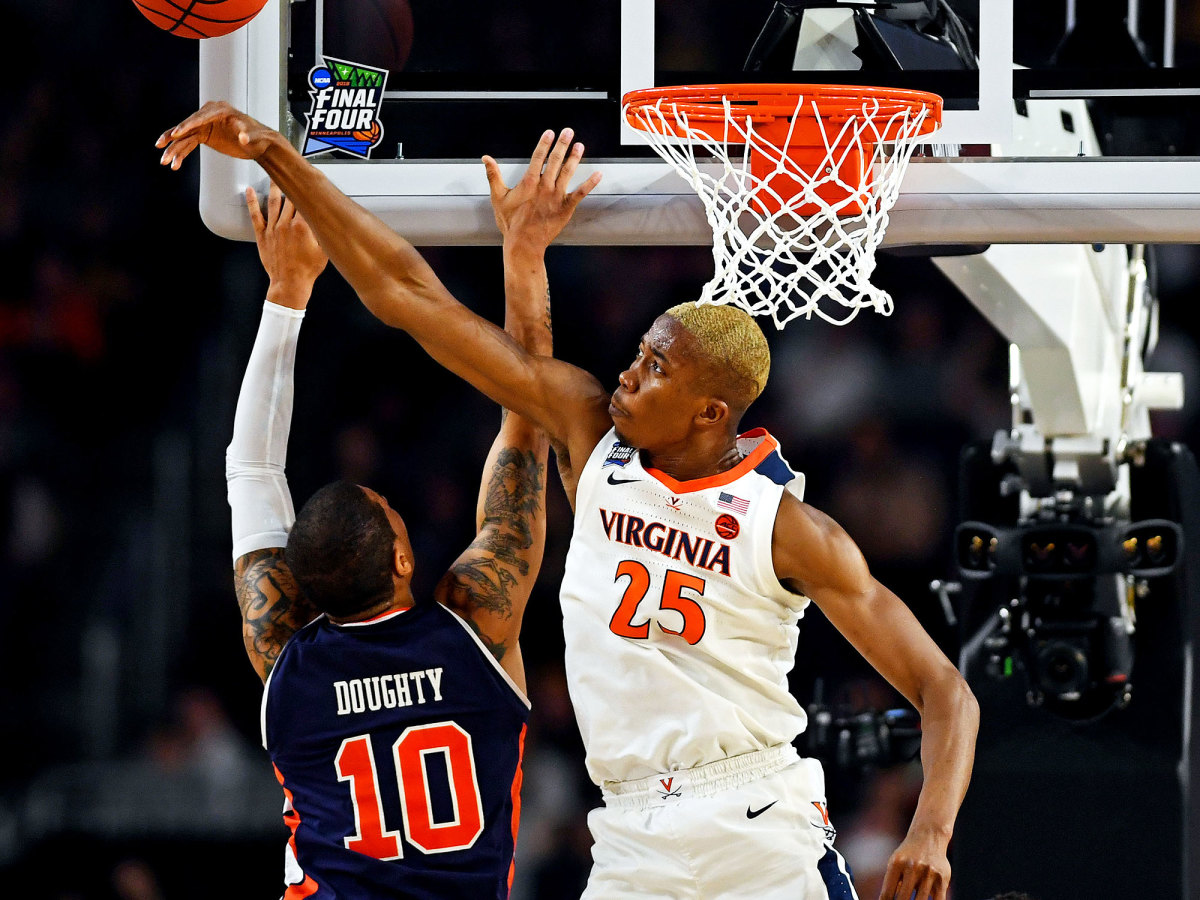
33. Mamadi Diakite, Virginia, Senior
Diakite already has his forever place in Virginia (and college basketball) lore after his improbable buzzer beater saved what became a national championship run, but the forward is going to have a lot on his shoulders in 2019-20. After the Cavaliers saw their Big Three depart, Diakite is going to be counted on to break out offensively, something he showed flashes of down the stretch and in the NCAA tournament. The senior will bring valuable experience to a much younger Hoos team, and his defensive presence and mobility (his 10.2% block rate was 24th nationally) will once again anchor the paint.
32. Bryce Aiken, Harvard, Senior
Harvard looks one of this season’s most dangerous small-conference teams, due in large part to Aiken, whose playmaking savvy and perimeter shooting (22.2 points per game while using a third of his team’s possessions last season) could make the the Crimson a dangerous match for high-major opposition. He’s succeeded in spite of his small stature, the entire roster returns around him, and he has room to improve from an efficiency standpoint. But Aiken’s quickness off the dribble and passing poise makes him the Ivy League’s top player, and one of the more unheralded star guards in the country.
31. Obi Toppin, Dayton, Redshirt Sophomore
Toppin is a physical force who looks ready to break out in full for a Dayton team with designs on A-10 contention. His play took off after moving into the starting lineup to close last season, averaging 17.9 points and 8.2 rebounds over his final 10 games, and he’s proven capable of some monster performances. Toppin has touch out to the three-point line, willingly bangs on the interior, and has a good feel for his own strengths. A huge year could be in store.
30. Tres Tinkle, Oregon State, Senior
Tinkle has been one of the most productive players in the country the past two years, racking up rebounds, assists and steals while logging heavy minutes as the primary option for Oregon State’s offense. Entering his final college season, the Beavers are charged with parlaying those numbers into an improvement on last year’s 18 wins. Tinkle can still improve as a three-point shooter, and expect his heavy diet of touches to continue. The impressive counting stats will surely be there, and if he finds another gear, the results may follow.
29. Andrew Nembhard, Florida, Sophomore
Nembhard had big shoes to fill as a freshman in taking over Florida’s offense from the departed Chris Chiozza, and the former five-star proved himself as a facilitator, posting the SEC’s second-best conference assist rate. The 6’5” point guard has good size, was a pesky part of an excellent Gators defense and showed a knack for the big moment, but the team as a whole needs to find the next level on offense to meet its top-10 expectations. Some of that starts with Nembhard, who will have more weapons at his disposal but will look to keep developing a shot that was 34.7% from three and 45.8% from two as a freshman.
28. Jaden McDaniels, Washington, Freshman
Blessed with unusual skill and fluid athleticism for a forward his size, McDaniels’s adjustment to the college game will be a major swing factor in Washington’s success. At his best, he’s extremely tough to defend, with the height to shoot over most defenders, the agility to create space for himself, and nice playmaking instincts. His slender build and still-developing handle will pose challenges when it comes to manufacturing touches, but once McDaniels finds a level of comfort and consistency, opponents will have a tough time keeping up. If he can be efficient shooting the ball and improve his three-point numbers, he’ll be one of the toughest matchups anywhere.
27. Killian Tillie, Gonzaga, Senior
Health is the single-biggest factor in how successful Tillie’s senior season will be—and perhaps Gonzaga’s as a whole. Foot and ankle problems cost the talented forward 22 games last season, and injuries have been a lingering issue throughout his career. Then, in early October he underwent a procedure on his knee that may delay his start to 2019-20. When he’s healthy, Tillie is a major piece of Gonzaga’s lineup, standing 6’10” with a knockdown ability from three (he’s shot 47% in 149 career attempts). His sophomore year, he was one of the country’s most efficient and best shooters while averaging 12.9 points, and the Zags would love to get even some version of that this winter.
26. Nico Mannion, Arizona, Freshman
Mannion arrives at Arizona worthy of his high expectations, with a maturity and sense of calm as a ballhandler that continues to set him apart from his peers. The Wildcats’ ability to challenge in the Pac-12 hangs on his steady distribution, with an array of scorers around him and real playmaking responsibility from the outset. While Mannion may not be ready to shoulder the load alone, he shouldn’t have to. His usual mixture of clever passing and opportunistic scoring will be a difference-maker.
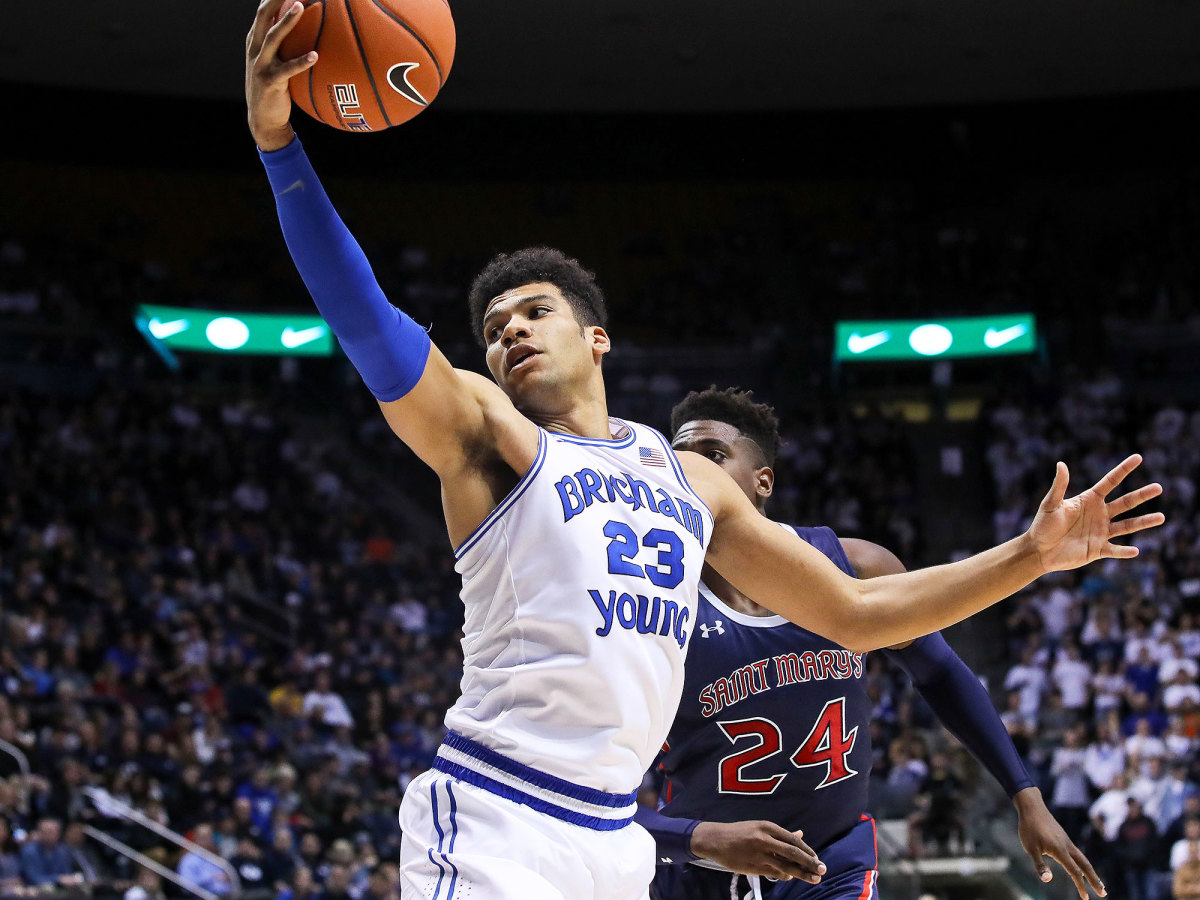
25. Yoeli Childs, BYU, Senior
Childs took home the crown for the offseason’s weirdest NBA draft journey, initially saying he would not return to BYU before announcing a last-minute reversal two weeks later. It was an immediate boon for the Cougars, who got back one of the nation’s most productive players. Childs is a double-double machine and nearly averaged one for his junior season, finishing with 21.2 points and 9.7 rebounds. He has a soft touch around the rim, where he converted 81.2% of shots, and while he can step out from three (32.3% in 2018-19), he’ll be even more dangerous if the strides he made from deep in WCC play last year (36.4%) are for real.
24. Tristan Clark, Baylor, Junior
Clark was leading the nation with a 73.7% field goal percentage when his sophomore season got cut short by a knee injury just 14 games in, dealing a tough blow to Baylor and ending what had been a promising rise for the big man. Back for a Bears team with much higher expectations this time around, Clark will likely take some time to get back into the fearsome form he had before his injury, but big things could await. The 6’9” center was hitting 86.8% of his shots at the rim and 57.1% of midrange jumpers, while also being a force on defense on the interior.
23. Grant Riller, Charleston, Senior
Riller was one of college basketball's best-kept secrets last season, putting together a massive statistical year for a strong Charleston team he efficiently led in usage. He's quietly built a case as the best mid-major guard in the country. Riller averaged 21.9 points and shot a ridiculous 61% on two-pointers last season, led the Cougars in assist rate, and nabbed CAA Preseason Player of the Year honors. He’s strong, shifty off the bounce, and a tough cover for just about any opponent, level aside.
22. Payton Pritchard, Oregon, Senior
Pritchard returns to Eugene as one of the best point guards in the nation, with a bevy of experience under his belt. The senior wasn’t as efficient as usual as a junior, averaging 12.9 points and shooting a career-low 32.8% from three, but like the Ducks as a whole, he turned it on down the stretch as the leader of a team that surprisingly won the Pac-12 tournament and then reached the Sweet 16. Pritchard’s high basketball IQ and shooting ability helps make up for what the 6’2” guard lacks in physical tools.
21. Ashton Hagans, Kentucky, Sophomore
Hagans makes his bones on the defensive end, where he served as the tone-setter for a top-10 Kentucky D last season. The Wildcats could be even better on that end in 2019-20, with Hagans once again expected to play a major role in generating steals and creating easy opportunities for his team. The point guard was top six in SEC play in both assist and steal rate, but must improve on an ugly 28.7% turnover rate. Any offensive strides by Hagans, who was tentative as a freshman when it came to shooting and made only 14 threes on the year, would be a boon.
20. Tyrese Haliburton, Iowa State, Sophomore
Haliburton largely went unnoticed last season as one of the best freshmen in the country, making contributions that went beyond the box score and augmenting a potent Iowa State attack with his unselfishness (3.6 assists per game), three-point shooting (43.4% on the year) and instinctive perimeter defense (1.5 steals per game). With much of the rotation turning over, the Cyclones will put the ball in his hands, aiming to unleash his passing skills and otherworldly offensive feel as the leader of their offense. While Haliburton has a bit to prove in this regard, his strong play at the U-19 World Cup sure looks like a positive indicator. As he adjusts to life as a full-time point guard, he could be in for a true breakout.
19. Xavier Tillman, Michigan State, Junior
Tillman put together a largely unheralded yet insanely impactful sophomore season, stepping into the starting lineup for Michigan State’s final 13 games and combining dominant play on the glass with efficient finishing around the basket. On the year, his box plus/minus score of 15.08 was third-best in the country and ranked as the 13th highest output since 2010 (according to basketball-reference data), putting him in rare company. Tillman might already be the best role player in the country. The Spartans hope he might be more than that.
18. Jalen Smith, Maryland, Sophomore
The biggest thing holding Smith back amidst a solid first season was inconsistency, and the big man appeared to hit the ‘freshman wall’ in mid-February. The former five-star recruit responded with a stellar two-game NCAA tournament in which his big-time potential was evident, and he’s on the shortlist of players nationally who could take a major step forward this year. The departure of Bruno Fernando means more space for the 6'10" Smith to operate in the paint, but he has the ability to stretch defenses all the way out to the perimeter. He must improve his outside shooting, however, after making just 26.8% of threes as a freshman.
17. Tyrese Maxey, Kentucky, Freshman
Kentucky will look to Maxey, their most college-ready freshman, to carry the scoring baton and spearhead a new-look rotation. He’s a polished, crafty scorer who has earned his reputation, and should provide a key dimension for the Wildcats as they establish offensive consistency, particularly early in the season. His skills creating off the dribble should be an ideal complement for Ashton Hagans. Maxey is a good bet to lead his team in scoring, and has clear one-and-done upside if all goes well.
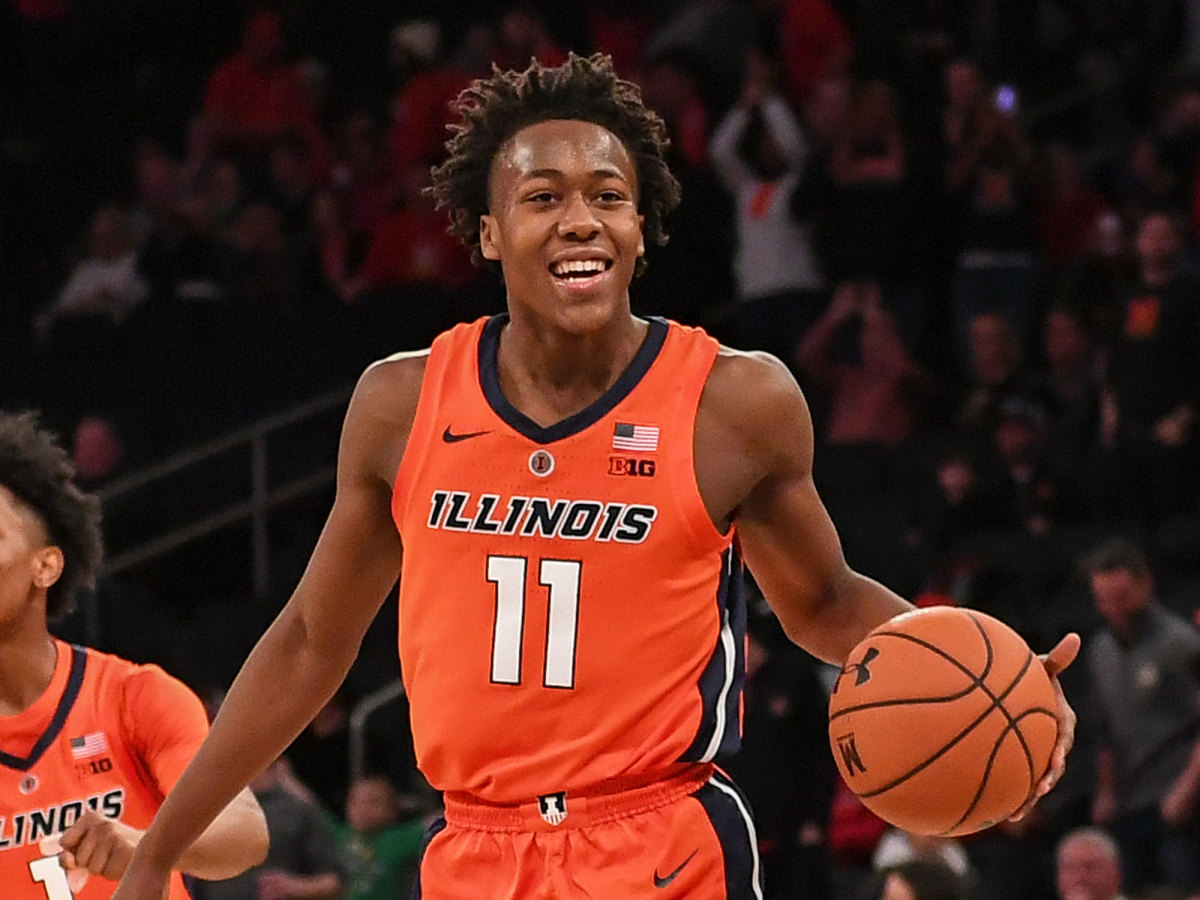
16. Ayo Dosunmu, Illinois, Sophomore
Dosunmu’s decision to return for his sophomore year puts Illinois back in the NCAA tournament conversation, at long last. His freshman year came with pronounced highs and lows, but a leap forward is the expectation. Capable of playing both guard spots, Dosunmu is a quality playmaker, pesky on-ball defender and sneakily solid scorer. If he can continue shoring up his jump shot and take on additional responsibility as a ballhandler, a big year should be in order.
15. Jarron Cumberland, Cincinnati, Senior
Cumberland made a big leap forward as a junior, averaging 18.8 points, 4.4 rebounds and 3.6 assists and shooting 38.8% from three as part of an AAC Player of the Year campaign. He took nearly a third of the Bearcats’ shots when on the floor as the clear offensive fulcrum of a team more known for its defense, though with Mick Cronin off to UCLA, that may soon change. The 6’5” Cumberland is set up for another big year, especially if he can either improve his midrange game or cut down on those shots in favor of getting to the rim, where he shot 56.2%, per Hoop-Math.
14. Udoka Azubuike, Kansas, Senior
Azubuike can be a dominant force by simple way of being gigantic, and it’s hard to overstate the sorts of problems his sheer enormity and physical style can pose for opponents. Listed at 280 pounds (before a purported drop in weight) Azubuike is a literal bruiser, and while he’s had real issues staying healthy, he’s a career 74% shooter from the field and an imposing presence for those who might consider attacking the rim. His free throw issues are real, and he’s certainly not the most versatile scorer, but Azubuike’s distinct strengths are far too much for most teams to handle. An injury-free year would make Kansas the clear Big 12 favorites once again.
13. Kaleb Wesson, Ohio State, Junior
Too-often-persistent foul trouble and a three-game suspension in March that nearly cost Ohio State an NCAA tournament berth loomed over Wesson’s sophomore season, but there’s no doubting the big man’s ability. A monster on the boards on both ends of the floor, he can do a little of everything, contributing with blocks, steals and even 26 threes in 2018-19. The Buckeyes’ offense comes to life with Wesson on the floor, and while he should have more offensive talent around him this season, he’ll remain the focal point. His potential is sky-high if he can cut down on the fouls.
12. Tre Jones, Duke, Sophomore
Jones is the first Duke five-star recruit to return for a sophomore year since Marques Bolden, and there’s been high expectations on the point guard ever since his April announcement. Jones has already proven he’s an elite defender, serving as a stingy on-ball presence who had the ACC’s seventh-best steal rate in conference play, and his 3.62 assist-to-turnover ratio as a freshman was third nationally. Now, the Blue Devils are hoping to see him take the next step in his own scoring ability, after he struggled with a 48.5% true shooting percentage and 26.2% mark from three.
11. Anthony Edwards, Georgia, Freshman
While carrying Georgia to a tournament bid will be a tall task, Edwards arrives as one of the most physically gifted players in the country. His strength and speed should enable him to make a big impact immediately, and the Bulldogs will live with his mistakes as he attempts to shoulder the scoring and playmaking load. He’s a dangerous shooter and improving playmaker off the dribble, and he’ll have a big athletic advantage over most competition. Expect some inconsistency, but as long as the highs outweigh the lows, Edwards should be a stat-stuffing presence and threat to score from all over the floor. His stay in college will be a short one, regardless.
10. Isaiah Stewart, Washington, Freshman
Stewart’s relentless energy and production inside the paint makes Washington a real candidate to repeat in the Pac-12; there will be few opponents well-suited to keep up with him around the hoop. Expect him to be an immediate double-double threat, punishing bigs with his strength and footwork and helping the Huskies limit second-chance points as a key rebounder within the 2-3 zone. There’s nothing flashy about his game, but Stewart’s impact should be tangible from the get-go. Expect him to be one of the most productive bigs in the country, freshman or otherwise.
9. Sam Merrill, Utah State, Senior
Leading a dangerous Utah State team that’s favored in the Mountain West, Merrill returns to build on arguably the best individual 2018-19 season that nobody really seemed to talk about. Merrill’s shooting splits sniffed rarified air: he averaged 20 points per game, shot 52.9% from the field, 90.6% from the line, and fell shot of a 50/40/90 year with a 36.9% clip from three (after nailing 45% of those in each of his first two seasons). His capacity to score from all over the floor is elite at the college level, made all the more impressive by the fact he was a strong distributor at the same time (4.2 assists per game to just 1.9 turnovers). Merrill could see even more usage this season, and as long as he maintains something close to past levels of efficiency, the Aggies will thrive, and have a chance to make serious noise in March.
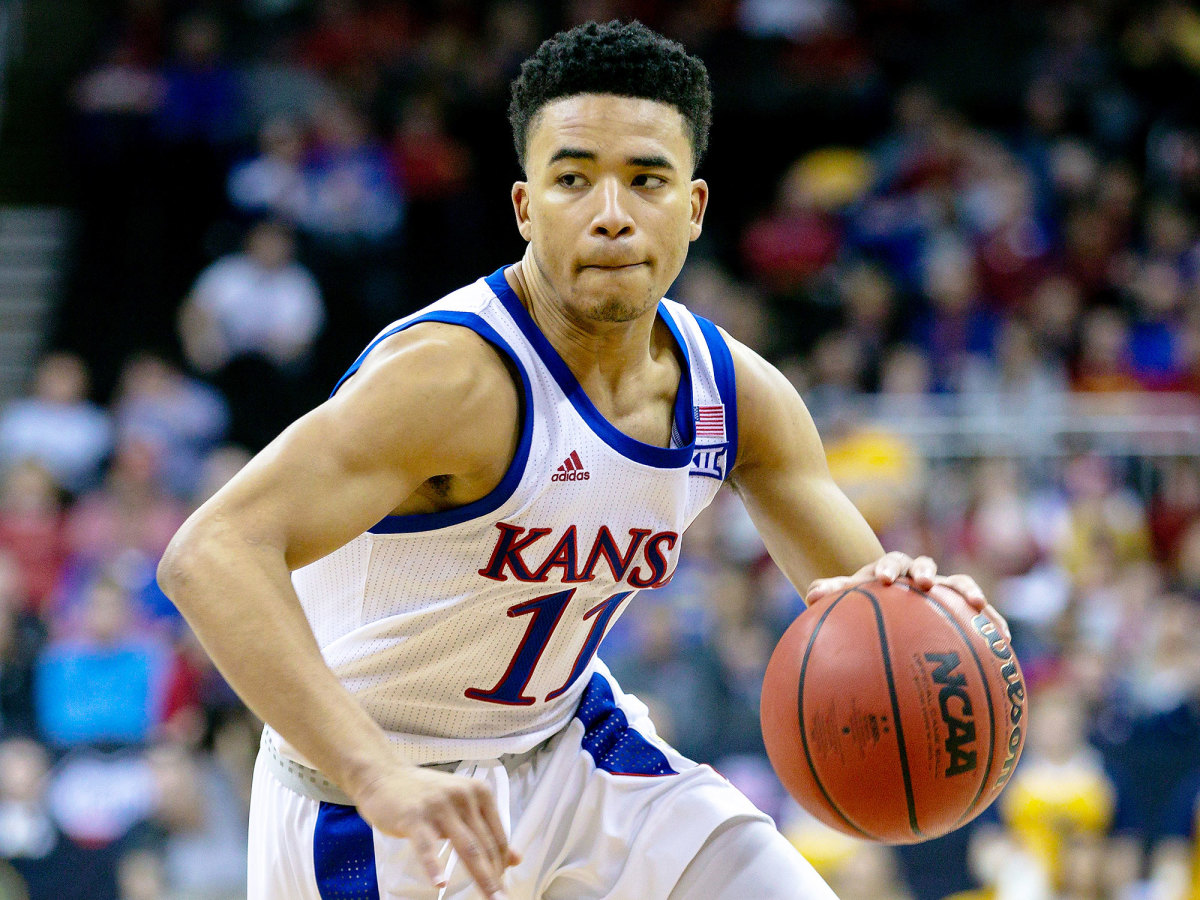
8. Devon Dotson, Kansas, Sophomore
Dotson’s development after a solid debut season (12.3 points per game on 48% shooting) is the key to everything for Kansas. He’s the engine of their attack, his small stature making him a difficult mark, and a tight handle allowing him to attack small spaces and disrupt coverages. He’s demonstrated a nice feel for decision-making, and the next step involves knowing when to be aggressive as a scorer, as well as which buttons to push around him. Dotson could lead the Jayhawks in points as well as assists, and as the team’s lone true creative player, his contributions will be even more pivotal this time around. He could have a case for National Player of the Year a few months from now.
7. James Wiseman, Memphis, Freshman
Bar none, Wiseman is the most physically gifted player in college hoops, with a body type built to play the sport, an unusual degree of explosiveness, and burgeoning ball skills, plus the fact he’s a nearly 7-foot center. He’ll scrape at double-double production simply by dint of being on the court, and Memphis will aim to keep him involved not only on the block, but as a screening threat and secondary playmaker. If he can channel his ability with consistent effort, Wiseman should be among the game’s most impactful stars, able to take over a game on the glass, as a rim-protecting presence, and with versatile offensive contributions.
6. Jordan Nwora, Louisville, Junior
Nwora creates a unique matchup problem for defenses with his potent jump shot: placing a bigger forward on him opens up the paint for others, while assigning a smaller wing dares Nwora to simply shoot over the defense. He made big strides over the course of his breakout sophomore season (17 points, 7.6 rebounds), making his individual shot selection more team-friendly, giving Louisville an offensive dimension it otherwise lacked, and becoming more efficient in the process. Nwora has enough of a handle to attack closeouts and keep defenders honest, and will benefit big-time from the influx of talent around him, helping to mitigate his deficiencies as a playmaker and as a perimeter defender. Another uptick in production is on tap.
5. Kerry Blackshear Jr. Florida, Senior
Capable of doing damage inside the paint or facing up from outside, Blackshear will be the immediate anchor of Florida’s attack, providing the go-to halfcourt outlet the Gators have sorely lacked. At Virginia Tech, he was one of the more unheralded, consistent performers in the country (14.9 points and 7.5 rebounds last season), and his passing ability and size on the interior should be a difference-maker. If he can sustain an effective three-point clip and open the floor up for a talented group of teammates, Florida should fall squarely in contention come March. There’s a reason Blackshear was the most sought-after grad transfer on the market.
4. Myles Powell, Seton Hall, Senior
Through steady progression, Powell has become perhaps the premier catch-and-shoot player in the country, someone who defenses must account for at all junctures, and the leader of a Seton Hall team many view as the favorite to win the conference. He stepped up comfortably into an expanded role as a junior, averaging 23.1 points per game. He was tasked with additional playmaking responsibilities in addition to darting off screens and creating space simply by being present. The capacity to serve as an efficient offensive focal point without having to dominate the ball is rare at the college level.
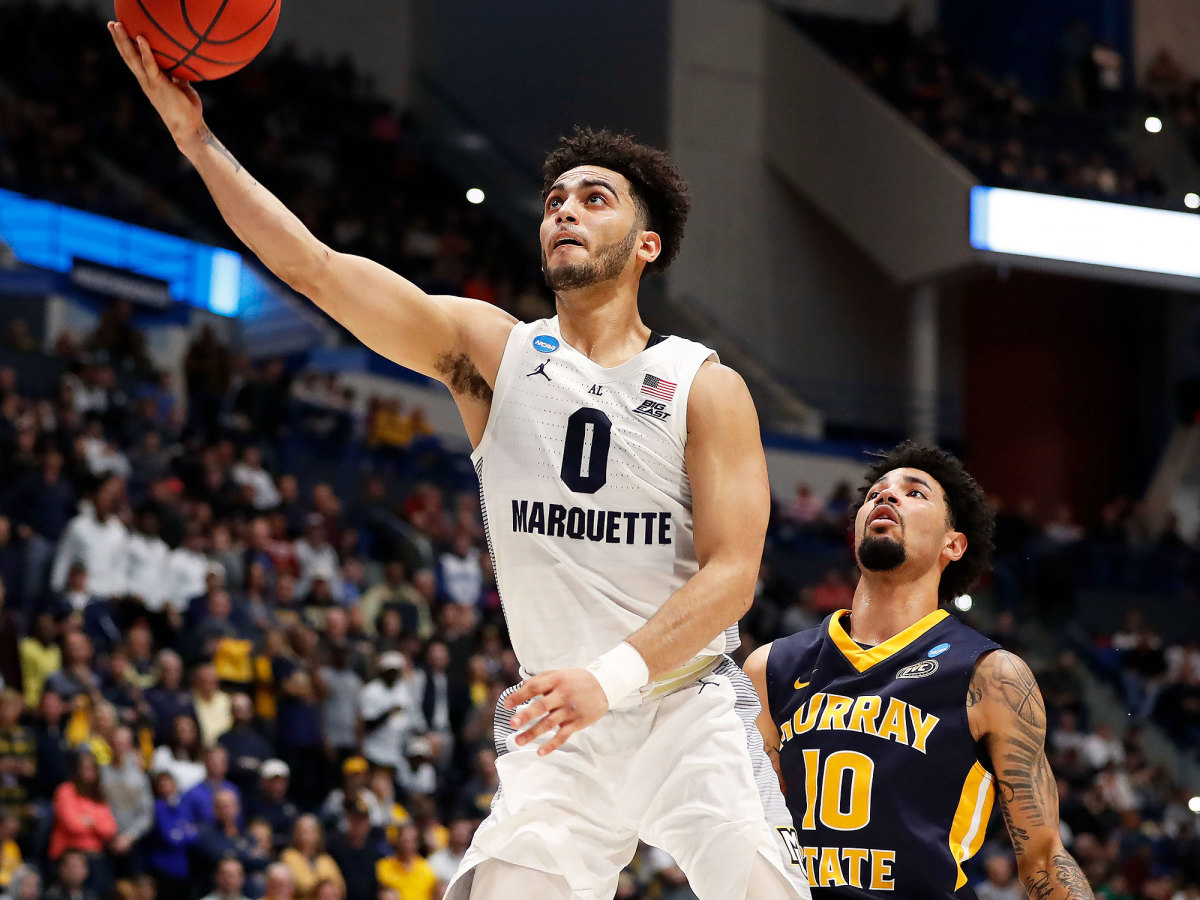
3. Markus Howard, Marquette, Senior
Howard’s unique capacity to post huge point totals (25 per game as a junior) and drain threes at high volume (40.3% on nearly nine attempts per game last season) makes him one of the most difficult covers in college basketball. He’s scored the way he scores over the past two seasons in spite of facing junk defenses on the regular, and Marquette will aim to better weaponize his skills away from the ball this time around and challenge for a Big East title. Howard doesn’t give you a ton defensively, and his small stature both helps and hurts him at times, but his overall offensive impact as a pick-and-roll playmaker and constant perimeter threat can’t be undersold. The only thing he has left to prove is that he’s capable of leading his team to wins in March.
2. Cole Anthony, North Carolina, Freshman
Anthony arrives in Chapel Hill as the most college-ready freshman in the country, with a polished offensive game and big-time scoring ability. He joins an overhauled Tar Heels team that will need him to shoulder a heavy possession count. He excels driving downhill and attacking the paint, but can also get hot quickly from distance. Anthony’s explosiveness, strength, and mature frame will set him apart at the college level and enable him to help Carolina on both ends of the floor. Expect big counting stats, some memorable performances, and immediate results.
1. Cassius Winston, Michigan State, Senior
After leading the Spartans to the Final Four with an immaculate series of performances to close last season, Winston returns with high hopes for a national championship. Capable of hurting opponents in spurts as a scorer or picking apart defense with the pass (he averaged 18.8 points and 7.5 assists as a junior), Winston is college basketball’s most proven star, and there’s little question he’s capable of a repeat performance. He’s developed into the type of savant you expect to win big regardless of circumstance, with an innate feel for when to score, when to get others involved, and how to manage a team. It would be unfair to hand the top spot to anyone else.
